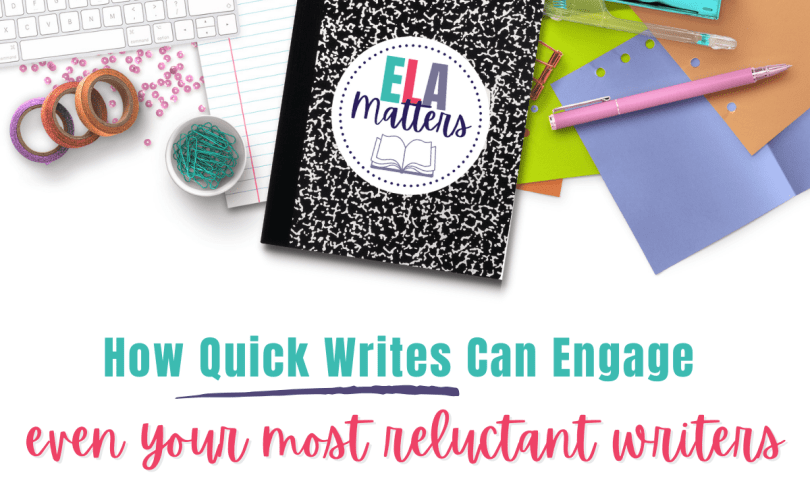For many of us, the idea of running a marathon within the next week will likely evoke a feeling of paralysis. We haven’t spent the past six months purposefully training for that volume, so our feelings of incompetence, overwhelm, and terror are entirely justified. Believe it or not, when it comes to writing essays, poems, or narratives, many of our students feel the same way. Sometimes, our most reluctant writers aren’t holding back because they lack specific writing skills. It may just be that they aren’t ready for that much volume in writing yet.
Quick writes can be an effective strategy for easing students into larger writing projects, and they have a unique way of bringing out the writer in all students. Plus, their flexible nature makes it easy to plug them into nearly any schedule, unit, or content area. Let’s look at how you can use quick writes to engage even your most reluctant writers this year.
What is a quick write?
Quick Writes are short, timed writing spurts that often require students to write about a specific topic or respond to an excerpt, photo, poem, or quote. According to Linda Reif, quick writes “use someone else’s words to stimulate their thinking.” Quick writes are intended to be done quickly (hence the name) before the writer’s internal censor kicks in.
How do you facilitate a quick write?
Quick writes are easy to implement. They take a small amount of time but pack a big punch. You need less than 5 minutes, a compelling piece of writing, and a pencil and paper to start.
To begin, you might share with students this excerpt from Matthew J. Kirby’s Icefall:
“I listen to the ice. It speaks to me of scouring winds, of cloudless nights, of endless cold. It measures its loneliness by the weight of its layers, the years and years of snow falling unobserved. I’ve been told its lament is loudest at the beginning of winter and the coming summer, as if it knows that is the closest it will ever come to warmth and thaw. As if it yearns for its own demise.”
Matthew J. Kirby, Icefall
After reading the excerpt aloud, ask students to think of an object in nature, such as an iceberg, a river, a rocky cliff, or the sands on the bottom of the ocean. Then, invite them to open their writer’s notebooks and write about the emotions of that object using personification, just as Matthew Kirby did.
Some days, you might write for 3 minutes. On other days, when students’ pencils are still ferociously moving across the page, you might extend it to 5.
I recommend writing with the students and displaying your notebook under a document camera as often as possible. Your reluctant writers will benefit from seeing you generate ideas, struggle to put things into words, and write authentically. Don’t be surprised if they take your ideas and put their own spin on them.
Afterward, you can quietly close your notebooks and continue with your daily lesson, or you can offer students a space (but not require them) to share.
Tips For Managing Quick Writes
If you teach middle or high school, you know all too well how quickly students “game” the system. Over the years, I’ve developed the following five rules when it comes to quick writes:
- Write the first thing that comes to mind. No thought or image is “not good enough.”
- Keep your pencil moving the whole time.
- Don’t judge or compare your work to the work of others. This isn’t the time.
- Don’t stress over the rules. Worrying about the placement of a comma or the spelling of a word will stop your flow.
- Understand that some days your writing will be better than others. That’s okay. Write anyway.
Because quick writes are intended to be a low-pressure form of writing that brings out the writer in all students, I don’t recommend grading what students write in a traditional sense. Not only do you not have the time, but in doing so, you force students to stress over the rules. This inhibits idea generation and writing fluency.
Instead, consider grading participation. You can do a quick notebook check once a week by circulating through the room and glancing at notebooks as students write.
If you want to be more involved (and build relationships with your introverts), you can have students turn in their notebooks once a month.
Spend up to 30 seconds to a minute per notebook skimming over entries and adding a comment or two. Then, give students a participation grade. Rotate your classes each week so you aren’t reviewing more than 25-30 notebooks at a time.
Why Quick Writes Work
Just like training for a marathon starts with running a couple of miles, writing an essay or a narrative begins with writing a few sentences.
Your reluctant writers will see quick writes as a low-pressure opportunity to take risks, find their voice, and generate ideas meaningfully.

